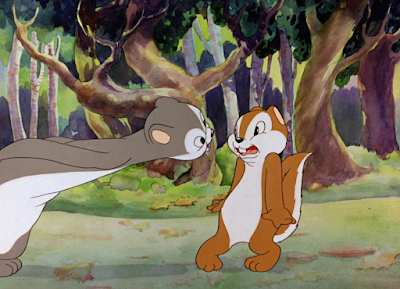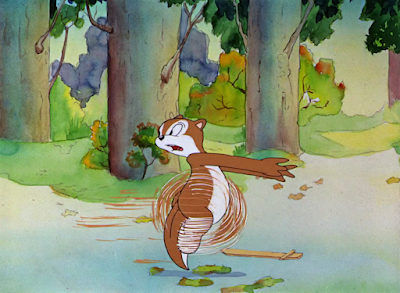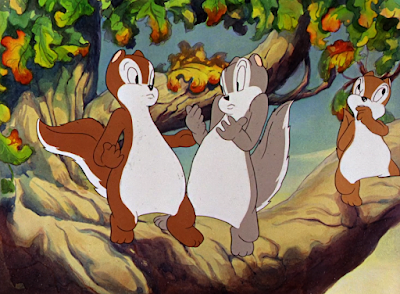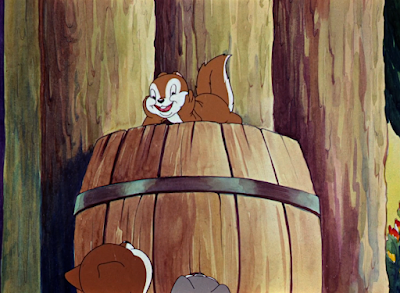Release Date: February 11th, 1939
Series: Merrie Melodies
Director: Chuck Jones
Story: Dave Monahan
Animation: Bob McKimson
Musical Direction: Carl Stalling
Starring: Berneice Hansell (Squirrels), Margaret Hill-Talbot (Squirrel), Mel Blanc (Fox, Squirrel imitating fox hunters)
Riding the coattails of the 1938 Academy Award winner The Adventures of Robin Hood, Chuck Jones increasingly cements the Disney influence in his cartoons. As a welcome surprise, Berneice Hansell is given significant coverage in the film, exercising her squeaky voice abilities with little sense of parody behind them. In fact, she's even able to put on a deeper voice, a very rare surprise coming from the woman dubbed as "Giggles" by the United Press in 1934.
Here, three squirrel brothers are all deeply engrossed in the story of Robin Hood. Opting to act the story out, the little brother who they were so quick to shun and pin as the villain finds himself saving the day from a hungry fox insisting he play the part of Maid Marian.
The first indication of its Disney influence is through an incredibly scenic establishing pan. For someone who dismissed the backgrounds in the '30s as "moldy prune backgrounds", the array of hues and variation of brush strokes in the trees, mountains, and other forest flora certainly assert otherwise. The lighting is particularly nice when the camera reaches the depths of the forest, sunrays bouncing off of the tree limbs and leaves.
When the camera comes to a halt, we then truck-in and dissolve to two squirrels engrossed in a book. Staging in the next shot of the squirrels reading is particularly clever, shot at a dynamic down angle and allowing the book's title to be visible over the roots propping it up. Despite the previous shot having the book nestled right up against the tree's bark, the shift for the sake of clarity isn't jarringly obvious.
As the two squirrels read silently to themselves, Jones fakes the audience by having a third squirrel pop up between its siblings, no indication of his presence prior. A squeaky "Boy, oh boy!" of delight fills the audience in to his opinion on the story.
Bob McKimson flexes his strength as the studio's top animator in the next scene of the little squirrel inviting his brothers to play Robin Hood. Lots of subtle movements, head tilts, intricate angles all wrapped in some very firm, realistic construction.
When the little squirrel declares that he'll be Robin Hood, his older brother pokes his head out into the screen. The violin slide, the domineering stance, the smile, and the brother's claims of "Who's gonna be Robin Hood?" in a slightly deeper voice all successfully convey his superiority.
Little squirrel gets the message, twiddling his thumbs. "Yuh... you're gonna be Robin Hood."
The same charade continues with the biggest squirrel, whose voice is even deeper than the gray squirrel's. This cartoon is a lovely showcase of Berneice Hansell's acting ability--it's been quite awhile since she's been played straight, her giggly voice to wholeheartedly signify cute. Even better, the brown squirrel's voice is considerably deep; with Hansell's voice acting so synonymous to her squeaky giggles, it's a lovely surprise to see her stepping out of her role.
While the scene does run a little long, Bob McKimson's animation pardons any glacial timing--had this scene been tasked to a weaker animator, it may have read as monotonous. Here, McKimson's eye for solid, believable acting and subtle, intricate movements pad any pauses and truly give these one-off squirrels a new sense of life.
With the brown squirrel tasked as Robin Hood, he appoints his gray squirrel comrade as Little John. When pondering who the villain will be, McKimson sneaks a wonderfully subtle detail of the gray squirrel watching his brother's movements and trying to mimic them. That may be expected from the littlest squirrel, but to see the middle child also trying to imitate his brother is a fun twist, as well as an easy way to note the brown squirrel's dominance over his brothers.
Together, the eldest brothers ponder in squeaky unison: "Now, who's gonna be the old villain?"
Cut back to the littlest squirrel, who ponders the same, mimicking his own brothers.
The camera panning out to reveal the two squirrels standing in frame, glowering at their brother like a fresh morsel, speaks more words than any sort of verbal reply. Such could be said for the littlest squirrel, who looks to see if anyone else is standing nearby.
No dice. His incredibly squeaky "Meeeeee!?" would be repurposed by Jones with Sniffles in Sniffles Bells the Cat, voiced by the equally bubbly Margaret Hill-Talbot.
A unanimous nod solidifies his fate.
Some nice smears as the little pipsqueak looks around before making a break for it. Instead, he's easily lifted up by the scruff of his neck.
The next sequence shows earmarks that were present even in Jones' days as an animator--that is, shadows. Jones loved to employ shadows particularly during this period to stress the dramatics of a certain scene--sometimes they can verge on uncanny territory without the accompanying moody lighting, but certainly elevate the artistic direction of his shorts. Another holdover of his Disney influence--it'd be quite rare to spot a close-up like this in a Bob Clampett cartoon. At least, one that looked as dimensional or as good as this one.
Here, the squirrel reassures him that there's no reason to get upset. "All ya gotta do is march t'rough the forest with your treasure, an' we'll rob ya and give it to the poor!"
"Won't that be fun?"
A shake of the head no is quickly replaced with a cheesy grin and a nod, another telltale early Jonesism.
While the sequence does drag on in parts, solid animation and acting once again break up its monotony--the intimidation and hierarchy of the squirrels is very clearly established, especially when the gray squirrel claims "He wants to be the villain!"
"Dont'chya?"
More furious nodding in response.
Sensing that another escape is imminent, "Robin Hood" himself catches his brother by the tail as he makes a mad dash for it. Nice elasticity and solid weight as he comes crashing back into his brother.
More McKimson trademarks are present as the eldest brother dons their very own villain in the appropriate garb. A sack, a wooden sword, and a tin pot for a hat that's much too big (harkening back to Tommy's own ill-fitting hat in The Night Watchman) prompt the eldest squirrel to perform some more solid head tilts and a satisfied flick of the wrists, a McKimson staple.
Another callback to Watchman, the littlest squirrel has a scene where he too trudges along forlornly, a whiny violin score in the background, bemoaning how he's not being taken seriously.
In a contrast to the aforementioned cartoon, his comeuppance isn't delivered. Instead, his point is proven even more through a musical number and the sudden appearance of Little John.
Altering the lyrics to the song "For You", Berneice Hansell gets to flex her squeaky, sickeningly cute vocals for an entire song. The number is certainly catchy, though undeniably sung by Hansell--that is, very squeaky, loud, and high pitched.
In the midst of the squirrels battling, the conflict is also introduced in the song through the silhouette of a fox. He observes their playing before spotting the Robin Hood book left in plain sight.
A brief bit of studying is in order. Frequent grimaces towards the singing squirrels quickly indicates that the fox's intentions are nefarious. His all knowing grins towards the audience are a well known Jones trademark of past and present--while it took Jones quite awhile to truly find his style, many of his sensibilities can be seen trying to pop out of the ground in these early shorts. The fox certainly seems very similar to Wile E. Coyote in terms of his mannerisms.
Nevertheless, their heroic battle is interrupted by a shrill, falsetto-y cry of "HELP!" from off-screen. Any and all bravery and dominance exuded by the brothers taunting their villain is lost in an instant as they scramble off screen.
The swords and hats thrown into the air in the midst of their hurry come landing back to earth, sticking neatly into the ground as a reminder of their presence.
Cue yet another Disney-esque (yet very gorgeous) vertical pan, following a large tree. The camera halting on the leaves signals that the tree is occupied.
Indeed, the eldest squirrel tentatively pokes his head out. "Who... who's there?"
So far, Billy Bletcher has been heard in falsetto, Tedd Pierce has been heard in falsetto, but Mel Blanc has hardly performed any falsettos during this period in time--surprising considering how good he is at them. Indeed, he conveys the perfect amount of insincerity in the fox's vocals as he introduces himself as Maid Marian.
His silent giggles to himself are, again, pure Jones.
Hiding in the branches, the squirrels are unfamiliar with this elusive Maiden.
Following more patterns established in the beginning of the short, the two eldest squirrels head onward, leaving the littlest squirrel in his own feigned pondering.
He, too, catches up to his brothers, his run cycle slightly weightless and not exactly displaying the urgency present in earlier sequences.
My earlier point about McKimson's animation elevating otherwise monotonous scenes certainly applies to this next sequence of the squirrels encouraging the littlest to get the book. The animation isn't bad by any means, but the spacing of the animation is too even, the timing too slow, serving as a stark contrast to the hurried, alarmed music score in the background. Such is particularly evident when the brothers throw the littlest down the tree--even spacing makes it read mechanically and underplayed.
A relatively excessive shot of the squirrel hanging on a limb and being signaled to go down slows things down further.
In any case, the squirrel does receive the book, narrowly avoiding the hungry fox in hiding. Instead, he swallows a mouthful of flowers that were hidden by the book--the gag doesn't translate as well, as the flowers are hardly visible--if at all--before the fox grabs them, as though they appeared out of thin air.
The fox's reaction to the flowers is much too slow as well, yet rife with Jonesisms that would be refined to be quicker, snappier, and funnier in the future, particularly the bewildered glance at the audience.
Segue to a more relaxed scene of the squirrels perusing their book and discovering Maid Marian. The book's Maid Marian is more akin to Olivia de Havilland's portrayal in The Adventures of Robin Hood, as opposed to an actual illustration of a 19th century maiden.
Upon discovering that Marian is his love interest, "Robin Hood" insists they save her.
His cries of "Where are ya, Maid Marian?" are once more a little too spread out and slow to convey much urgency, accounting for the necessary reaction time of the fox to hear him.
However, the fox does indeed hear the cries, and answers back in a deep, regular voice: "Here I a--"
Catching his mistake, he clears his throat.
Falsetto resumes with accompanying eyelashes. "Here I am!" Blanc would soon perfect the timing of the gag in upcoming cartoons, but remains nonetheless amusing here.
The back and forth between the fox's cries for help and Robin Hood's "Where are ya?" grows bloated, particularly when the littlest squirrel has to catch up to his brothers yet another time (harkening back to the issues in Dog Gone Modern with the dishwasher--once or twice is funny, three or more is pushing it.)
Regardless, it's nice to see the camera movement play a big role in the sequence, the squirrels hoping from limb to limb in a constant pan. Variations of "Where are ya?" "Here!" continue to a monotonous degree, the chase eventually leading the fox to a nearby cabin. The vibrant tones in the trees, the cabin, the shrubbery and the mountains once again refute any and all claims of moldy prunes.
At long last, the squirrels stumble upon the cabin and dart inside. The fox, waiting on the other side, sneaks up along the cabin and hungrily observes their entrance.
While the wood detailing on the walls are a little busy, they certainly provide a nice atmosphere with just how prominent their texture is. At long last, the squirrels have discovered Maid Marian.
That is, Maid Marian locking them in and breaking her falsetto. While the animation of the fox's close-up is a little crude, probably better suited for someone like Bob McKimson who is easily able to nail any tricky perspective, Blanc's vocals of "And I like little squirrels very, very much!" are delightfully sinister.
Enter the straggler, still clinging to Jones' cutesy remnants by falling from the tree. He's about as big as his brothers when they were shown in the wide shot entering the cabin, if not bigger--perhaps for clarity? It's not nearly enough to break the scene or even all that noticeable, but intriguing nonetheless.
Cut to a close-up shot of the littlest squirrel peering in on his kidnapped brothers. Jones' staging throughout the cartoon is rather impressive--while the angles and composition isn't nearly as inventive as Frank Tashlin's work, Jones employs negative space well, particularly by showing the action happening through the door. The squirrel in the foreground is unobtrusive, but adds an added severity to the situation--he's about to watch his brothers get killed.
The same staging continues for quite some time as the fox lists off all the things he loves about little, fat, juicy squirrels. "Especially with carrots... and potatoes... and uh, and uh... ONIONS!"
"Doesn't that just make your mouth water?" Blanc is the clear winner of the scene.
Rod Scribner animates the squirrel's realization of his brothers' fate, easily recognizable through the distortion in his eyes and sharp, tapered fingers.
In the midst of his scrambling, the squirrel trips over a nearby metal funnel. He's sent tumbling, taking a few rolls to come to a dazed standstill.
When he does, recognizing the funnel's decidedly hornlike shape, inspiration strikes in the form of a grin.
Dissolve to the fox preparing himself a dish of squirrel stew, innocuous humming always a must. The calendar in the back is dated "Octember"--a running joke previously seen in the newspaper headline in Porky's Double Trouble. The Binder branding on the stove is a nod to studio assistant producer Henry Binder.
However, his soon to be feast is interrupted by the all too familiar sounds of a trumpet outside. The flow of the animation as the fox discards his ladle, running up to the door and pressing his ear to it is particularly nice.
Outside, the source of the commotion is revealed: the squirrel blowing into the funnel and imitating the bark of a dog, now voiced by Mel Blanc.
The fox's exit as he struggles to run to the back door and open it is much too slow and sluggish to convey any sort of urgency, but the drawings are attractive and the movement flows well--just not the type of movement required for the demands of the scene.
Indeed, the short's highlight comes from the fox's increasing cowardice, stressed as the squirrel threatens to break the door down. Rod Scribner's artistic trademarks are particularly evident in the fox as he literally turns yellow with fear, wrinkles and fur and giant eyes abound. He begs for the "fellas" to help him escape, but they merely look on.
"Guess we'll have fox stew tonight, boys!" Mel Blanc still voices the squirrel outside, convincingly putting on a man's falsetto on top of his already manly voice.
While the back and forth running of the fox between the door and the squirrels is quick to grow monotonous, they, like McKimson's earlier scenes in the cartoon, have enough artistic merit and visual interest in them to soften any fledgling direction.
Admittedly, the fox bursting the door down and running outside WITH the door could use some sound effects to make the action more clear, but is plenty discernible on its own. Mel Blanc's vocals convey the urgency absent in the previous scene, and the yellow brush lines on the fox are visually striking. The fox pausing to sob into his arms as he continues to run is another whimsical touch.
Dissolve back to the cabin, front door still intact as the squirrels have somehow managed to free themselves (no questions asked!) They're quick to express their gratitude with a "Gee fellas, thanks a lot!"Unfortunately for them, there are no fellas in sight. Confused glances turn upward after a squeaky, off-screen clearing of the throat.
A final "Who's gonna be Robin Hood?" rightfully puts the little squirrel in his deserved place.
Robin Hood Makes Good is undoubtedly an early Jones cartoon and has all the earmarks of an early Jones cartoon. That's not always a bad thing, and quite the opposite. The backgrounds are gorgeously lush and vibrant, Bob McKimson's character acting blows everything out of the water, Rod Scribner's animation is delightfully energetic in terms of the drawings, Berneice Hansell getting to step slightly outside of her usual zone is very much a welcome treat, Mel Blanc's performance as the fox is incredible, and many Jonesisms weasel their way in here that would soon be refined to bigger and better usages.
With that said, the cartoon does suffer from the vices inherent to an early Jones cartoon, namely molasses timing and being too cute for too long. I personally don't mind much of the cuteness in his earlier works, but there does come a point where the sluggish timing makes it extend its welcome. The fox trying to escape from the "hunters" was too back and forth and too slow to feel properly frenzied, which could also be said for the squirrels attempting to track down their Maid Marian. Where animation suffered, it was typically a result of the actual mechanics of animation at hand--spacing, timing, etc.--rather than the drawings themselves.
For all of Jones' Disney imitations, this cartoon is easily one of the more pleasant entries. It does its Disney imitation well, though there's clearly no fooling between a 1939 Disney cartoon and a 1939 Warner cartoon. Dialogue absolutely does help--pantomime cartoons are wonderful, but the Jones pantomime cartoons of this era (such as Dog Gone Modern) certainly feel much longer than the Jones cartoons with dialogue. But, as most Jones shorts from this era, it's all in good fun.
Enjoy! The cartoon is also available on HBO Max.












































































































No comments:
Post a Comment